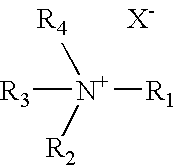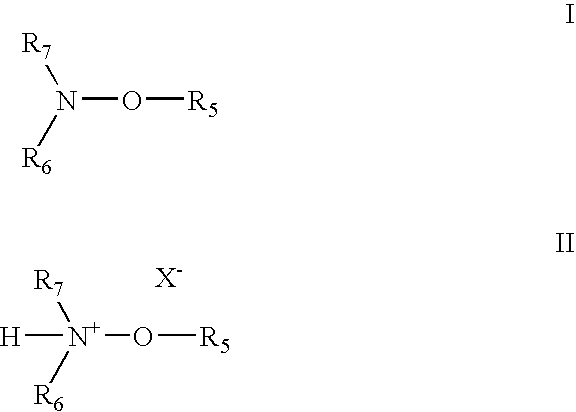Two step cleaning process to remove resist, etch residue, and copper oxide from substrates having copper and low-K dielectric material
a technology of dielectric materials and substrates, applied in the direction of detergent compounding agents, inorganic non-surface active detergent compositions, instruments, etc., can solve the problems of dielectric properties, low-k dielectrics in particular may be damaged, and react with and be damaged
- Summary
- Abstract
- Description
- Claims
- Application Information
AI Technical Summary
Benefits of technology
Problems solved by technology
Method used
Image
Examples
cleaning example 1
[0076]Two portions of a wafer were immersed in Formula S2X9 at 50° C. for 300 seconds (“s”). A first portion was rinsed in deionized water (“DIW”), and a second portion was rinsed in isopropyl alcohol (“IPA”); then in DIW. Residues remained on vias and trenches on both portions of the wafer. Another portion of the same wafer was immersed in Formula S2X9 at 30° C. for 90 s, then in CSX-W22 at room temperature for 30 s, and then in DIW. The residue was cleaned and no corrosion noted. Another portion of the same wafer was immersed in S2X9 at 30° C. for 90 s; then in CRX05-009 at room temperature for 30 s; then in DIW. The residue was cleaned and no corrosion noted. This example demonstrates that a process that combines the use of a fluoride formulation with a rinse formulation can remove residues that neither (1) a fluoride formulation alone nor (2) a fluoride formulation in combination with an IPA rinse can remove. This example further demonstrates that excellent cleaning results can ...
cleaning example 2
[0077]Nine portions of a wafer were immersed in S2X9 at 30° C. for 90 s. Each of the nine portions was then rinsed in one of EKC804, CSX-W22, CRX05-003, CRX05-004, CRX05-005, CRX05-006, CRX05-007, CRX05-008, and CRX05-009 at room temperature for 30 s; then in DIW. The residue was cleaned and no corrosion noted on each of the nine portions. This example demonstrates that the water component of the rinse formulation may range from 0% as in EKC804 to 90% as in CRX05-009, or even greater than 90%. This example further demonstrates that the solvent component of the rinse formulation may range from 0% as in CRX05-009 to 92.5% as in CRX05-008, or even greater than 92.5%.
cleaning example 3
[0078]A wafer was immersed in CSX-W22 at room temperature for 30 s, then in S2X9 at 30° C. for 90 s, then in DIW. The residue was cleaned and no corrosion noted. This example demonstrates that the rinse formulation step may be used prior to the fluoride formulation.
[0079]Although the examples used the technique of immersing the wafer portions into a beaker containing the formulations, one skilled in the art recognizes that the short contact times of the examples demonstrates that the cleaning process is well suited for single-wafer processing tools as well as batch processing tools.
PUM
| Property | Measurement | Unit |
|---|---|---|
| temperature | aaaaa | aaaaa |
| temperature | aaaaa | aaaaa |
| temperature | aaaaa | aaaaa |
Abstract
Description
Claims
Application Information
 Login to View More
Login to View More - R&D
- Intellectual Property
- Life Sciences
- Materials
- Tech Scout
- Unparalleled Data Quality
- Higher Quality Content
- 60% Fewer Hallucinations
Browse by: Latest US Patents, China's latest patents, Technical Efficacy Thesaurus, Application Domain, Technology Topic, Popular Technical Reports.
© 2025 PatSnap. All rights reserved.Legal|Privacy policy|Modern Slavery Act Transparency Statement|Sitemap|About US| Contact US: help@patsnap.com


